

Home - Teaching American History. Helping Teachers, Students and Youth in Northeast Ohio and Beyond. Elementary, Intermediate Tests and High School Regents Examinations : OSA : NYSED. Teaching Strategies in the Social Studies Classroom. Teaching strategies in the Social Studies classroom can be very daunting.
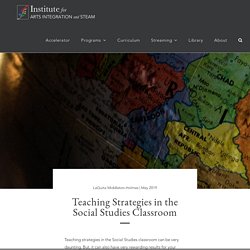
But, it can also have very rewarding results for your students when done with fidelity. Fortunately, social studies is a pretty all inclusive subject. However, in order to teach it, you have to hone in on a myriad of objectives for each topic. Consider these questions when planning your lessons. Pre-learning: What should students know prior to learning about this topic? During Learning: What specific activities will help students demonstrate mastery of the objective? Post-learning: What teaching strategies should be implemented to ensure students have a ‘long-term mastery’ of the objective? So, let’s get to discussing some of these strategies! Pre-lesson Strategies Strategy 1 – Power 60 – Pre-Write Write the topic on the board. During the 60-second period, teachers should move about the room and monitor student progress. Strategy 2 – The Ol’ Switch-a-Roo That’s better… Strategy 3 – The Great Inquiry.
Royal Sibling Feuds Through History. When family members are also co-workers, things can get messy.
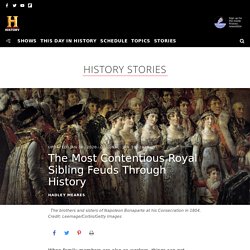
This is never truer than in royal families, where the interplay of private passions and public displays of affection or dissatisfaction are broadcast on an international stage. While some royal feuds remain minor, others in history have become so dysfunctional, they’ve led to major wars. Cleopatra's Family Feuds By the time the legendary Cleopatra VII was born into the ruling Ptolemy dynasty of Egypt around 69 B.C., the family already had an incestuous, murderous history. For generations, sisters had killed brothers, mothers had gone to war with their children, and sons had murdered their parents.
“After a while the butchery came to seem almost preordained,” writes Stacy Schiff in Cleopatra: A Life. “Rated false”: Here’s the most interesting new research on fake news and fact-checking. Editor’s note: There’s a lot of interesting academic research going on in digital media — but who has time to sift through all those journals and papers?
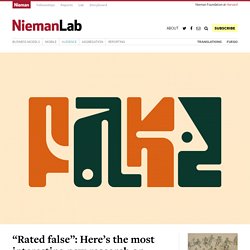
Our friends at Journalist’s Resource, that’s who. JR is a project of the Shorenstein Center on Media, Politics and Public Policy at the Harvard Kennedy School, and they spend their time examining the new academic literature in media, social science, and other fields, summarizing the high points and giving you a point of entry. Here, JR’s managing editor, Denise-Marie Ordway, sums up some of the most compelling papers on fake news and fact-checking published in 2019. (You can also read some of her other roundups focusing on research from 2018 and 2017.) Teaching Strategies. The history of Hong Kong, visualized. PUBLISHED August 26, 2019 Home to over seven million people, Hong Kong teems with life.

For weeks, it has also roiled with pro-democracy protests as millions take to the streets to demand political self-determination and personal autonomy. Sign In to Actively Learn. Classroom. History Assessments. Beyond the Bubble unlocks the vast digital archive of the Library of Congress to create History Assessments of Thinking (HATs).
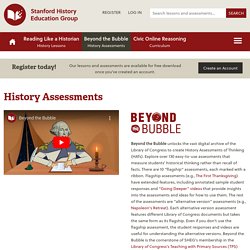
Explore over 100 easy-to-use assessments that measure students' historical thinking rather than recall of facts. There are 10 “flagship” assessments, each marked with a ribbon. Flagship assessments (e.g., The First Thanksgiving) have extended features, including annotated sample student responses and “Going Deeper” videos that provide insights into the assessments and ideas for how to use them. The rest of the assessments are “alternative version” assessments (e.g., Napoleon’s Retreat). Each alternative version assessment features different Library of Congress documents but takes the same form as its flagship.
Click here for a complete list of HATs. Checkology. History Engine: Tools for Collaborative Education and Research. Teachinghistory.org. I Love Social Studies! Modern Faith, America in the 1920s, Primary Sources for Teachers, America in Class, National Humanities Center. Trinity Church, New York City, 1916 4.
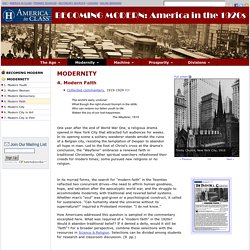
Modern Faith. Educator Resources. Educator Resources. American History. Best U.S.
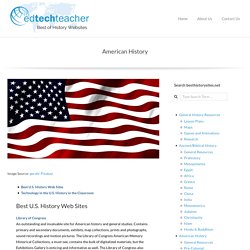
ProCon.org - Pros and Cons of Controversial Issues. Breaking News English Lessons: Easy English News Materials. Pew Research Center. The definitive fact-checking site and reference source for urban legends, folklore, myths, rumors, and misinformation.
Teaching History with Technology (new site) – from EdTechTeacher. Gilder Lehrman Institute of American History. WhatWasThere - Put history in its place! IWitness - Education through Genocide Testimony. Liberation Heroes: The Last Eyewitnesses Explore classroom-ready resources in support of USC Shoah Foundation's new documentary, Liberation Heroes: The Last Eyewitnesses, which premiered on the Discovery Channel in honor of Holocaust Remembrance Day.
Explore » Stronger Than Hate Stronger Than Hate empowers students with the knowledge, skills and dispositions they need to counter hatred and indifference in their daily lives. By engaging with the stories of survivors and witnesses of genocide, students confront the difficult reality of hate, and explore how they can respond to hate through action. Learn More » Schindler's List ~ 25th Anniversary One person can make a difference and that person is you! Discover flexible teaching tools from Schindler’s List education partners designed to accompany student screenings of the film later this fall. Learn More »
Lesson Plans. Current Events. Geography. Map Tools. Time Line Tools. America: A Narrative History, 8e: W. W. Norton StudySpace. US History Tours powered by Google Earth.
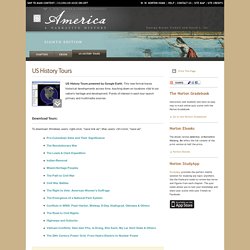
This new format traces historical developments across time, touching down on locations vital to our nation's heritage and development. Create your own country. The Wonderment. TPS Teachers Network. World History In Context. NEH-Edsitement.